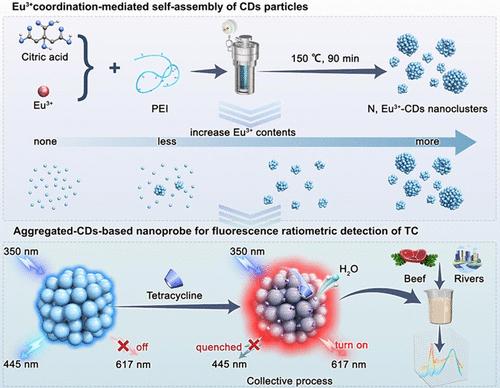Europium(III) Coordination-Mediated Self-Assembly of N-Doped Carbon Dot Nanoclusters for Ratiometric Detection of Tetracycline
IF 6.7
1区 化学
Q1 CHEMISTRY, ANALYTICAL
引用次数: 0
Abstract
Effective control of carbon dot (CD) self-assembly into larger nanoclusters in the liquid state for ultrasensitive detection is challenging and still in its infancy. For the first time, a europium(III) coordination-mediated strategy for self-assembly of N-doped carbon dots into large nanoclusters (N, Eu3+-CD nanoclusters) in aqueous solution was developed. It was found that the sizes and photoluminescence (PL) properties of nanoclusters could be effectively tuned by adjusting the Eu3+ content. The larger clusters with relatively longer fluorescence lifetimes were obtained by increasing the Eu3+ content. The simultaneous coordination of multi-CD particles with a Eu3+ and a dot particle with multiple Eu3+ was the key to inducing the self-assembly of CDs and regulating their optical properties. Furthermore, a dual-emitting N, Eu3+-CD nanocluster-based probe was constructed for the fluorescence ratiometric detection of tetracycline (TC). Once introducing TC, the blue emission of CDs was quenched through an IFE effect, but red emission of Eu3+ was significantly sensitized through an AE effect. Taking advantage of aggregation of CDs in aqueous solution, the N, Eu3+-CD nanocluster possessed a high sensitivity for detection of TC due to the spatial proximity of a large number of sensing units in the aggregated nanocluster assembly. The detection limit for TC was low to 35 nM. This work will provide a new insight into tuning the self-assembly of CDs and to regulate the photoluminescence and sensing performance of CDs.

铕(III)配位介导的n掺杂碳点纳米团簇自组装用于四环素的比例检测
有效控制碳点(CD)自组装成更大的纳米团簇在液态超灵敏检测是具有挑战性的,仍然处于起步阶段。首次建立了一种铕(III)配位介导的N掺杂碳点在水溶液中自组装成大纳米团簇(N, Eu3+-CD纳米团簇)的策略。研究发现,通过调整Eu3+的含量,可以有效地调节纳米团簇的尺寸和光致发光性能。通过增加Eu3+的含量,可以得到较大的簇,荧光寿命相对较长。多cd粒子与一个Eu3+的同时配位和一个点粒子与多个Eu3+的同时配位是诱导CDs自组装和调节其光学性质的关键。此外,构建了一种双发射的N, Eu3+-CD纳米簇探针,用于荧光比例检测四环素(TC)。一旦引入TC, CDs的蓝色发射通过IFE效应被淬灭,而Eu3+的红色发射通过AE效应被显着敏化。利用CDs在水溶液中的聚集特性,N, Eu3+-CD纳米团簇对TC的检测具有很高的灵敏度,这是因为聚集的纳米团簇中有大量的传感单元在空间上接近。TC的检出限低至35 nM。这项工作将为调整cd的自组装和调节cd的光致发光和传感性能提供新的见解。
本文章由计算机程序翻译,如有差异,请以英文原文为准。
求助全文
约1分钟内获得全文
求助全文
来源期刊

Analytical Chemistry
化学-分析化学
CiteScore
12.10
自引率
12.20%
发文量
1949
审稿时长
1.4 months
期刊介绍:
Analytical Chemistry, a peer-reviewed research journal, focuses on disseminating new and original knowledge across all branches of analytical chemistry. Fundamental articles may explore general principles of chemical measurement science and need not directly address existing or potential analytical methodology. They can be entirely theoretical or report experimental results. Contributions may cover various phases of analytical operations, including sampling, bioanalysis, electrochemistry, mass spectrometry, microscale and nanoscale systems, environmental analysis, separations, spectroscopy, chemical reactions and selectivity, instrumentation, imaging, surface analysis, and data processing. Papers discussing known analytical methods should present a significant, original application of the method, a notable improvement, or results on an important analyte.
 求助内容:
求助内容: 应助结果提醒方式:
应助结果提醒方式:


